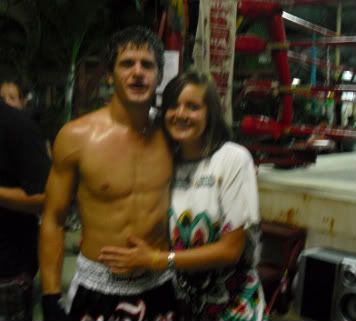Ok, I am a little ashamed of my pathetic whining below. I will continue on with the same story. One thing that should help is that I can ignore what I have already written. Since I am unsure which direction I want the story to go, I can write different scenarios, conversations, etc. and just scrap the ones I don't like or don't match in the editing process.
As we were then...
Saturday, October 31, 2009
NaNoWriMo - Day 6
In over my head. The story's plot was nice and neat in my outline, but it is all over the place now. It's not even the same story. Got about 1,300 words in today, whilst nursing a hang-over, but I'm having a lot of trouble getting the story on track. I may have bitten off more than I can chew for a first novel. Something more simple as a storyline like "The Old Man and the Sea" may have been a better idea.
Debating whether to scrap this story for a different one, and just start again tonight at midnight for the official challenge.
Word Count: 5,701
Debating whether to scrap this story for a different one, and just start again tonight at midnight for the official challenge.
Word Count: 5,701
Friday, October 30, 2009
NaNoWriMo - Day 5
What utter crap this story is turning into. And I am way behind. Need to write about 2,700 words on both Saturday and Sunday to catch up.
Swell. That should go great with my hangover.
Word Count: 4,435
Pages: About 11.5
Swell. That should go great with my hangover.
Word Count: 4,435
Pages: About 11.5
Big Sur Camping
The first time that I really hung out with Will and Steve was on a camping trip up to Big Sur in Northern California. I had already been good friends with Onn, and knew Lina from work. Other close friends like Mike, Kalvin, Audrey, and Aleida have joined for some of the road-trips. Will had found the place by word of mouth while surfing along the Northern California coastline. It is not a campsite, and it is illegal to have fires. The few people who know about it camp there often, and what’s camping without a campfire? Local authorities seem to look the other way about it, and we have never been bothered. From that first initial trip, we have been back up there several times, and close friendships were made stronger for the adventures.
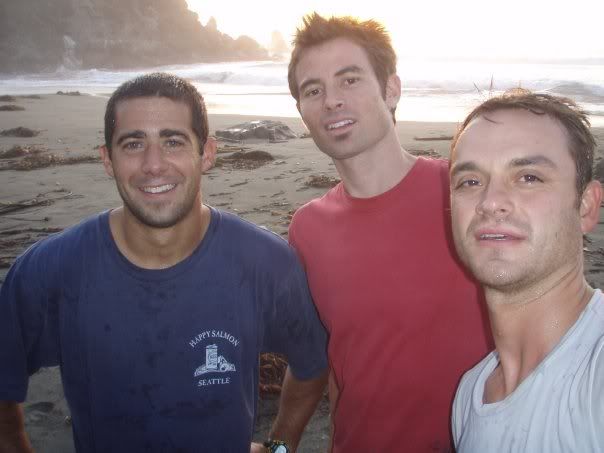
This last trip was at the end of September. Lisa and I drove South from San Francisco and met up with Will, Lina, Kalvin, Audrey, and Aleida in San Luis Obispo. We had our customary sandwiches and beers at the local grocery store, and then debated whether or not to make our hike to the top of the SLO Hill. We always have this debate. The beers are cold and the weather is hot, and trail hiking just seems like too much work. But we always go.
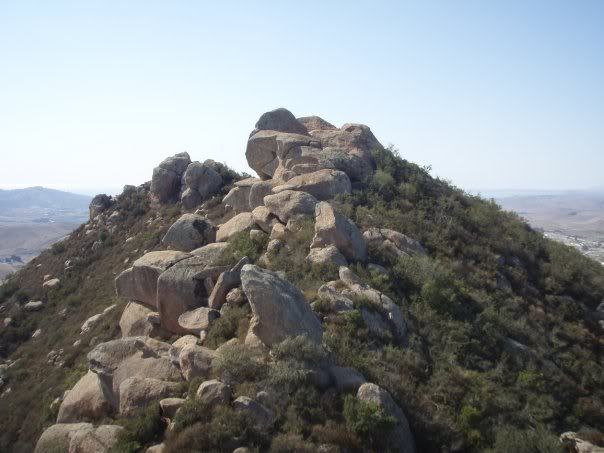
Aleida and Audrey set a land-speed record, finishing the hike in approximately 18 seconds. The rest of us mere mortals followed in the wake of their dust and mocking laughter. Lina was a good sport this time, and didn’t kick dirt in my face. Lisa made her first summit without kicking or screaming at me. We all lounged at the top, drinking the finest of warm, Mexican piss-beer and enjoying the view.
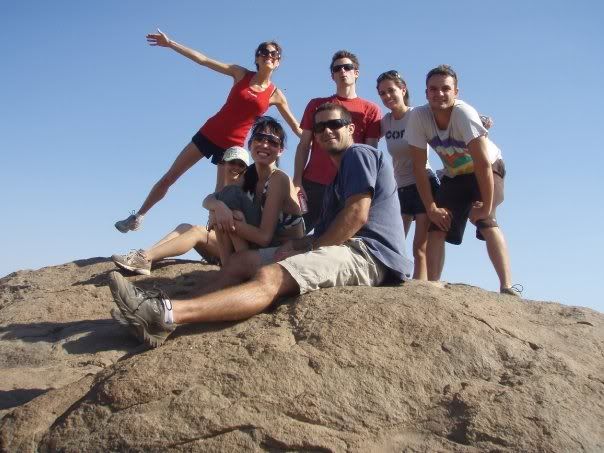
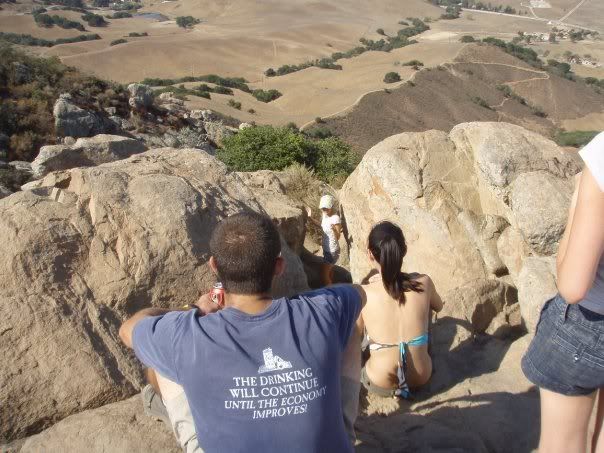
A stop for refreshments, candy, and more beer later, and we were back on the road. We found the spot, which is always a bit tricky, and started bringing our stuff into the forest. I have noticed that bringing women on the camping trips causes the overall volume of supplies to quadruple. I have also noticed that bringing women on the camping trips ensures that dinners don’t consist of beef jerky and trail mix, or God Forbid, Steve’s “coffee.”
We set up tents, and then Kal, Will and I went down to the shore to get driftwood for the fire. Kal jumped into the ocean like a fucking lunatic. Apparently, he doesn’t watch Shark Week, since Nor-Cal is the site for approximately 87% of the world’s Great White Shark attacks. Feeling like a complete Nancy, I stripped and jumped in too. Will doesn’t feel peer pressure, so he just watched and laughed at us.

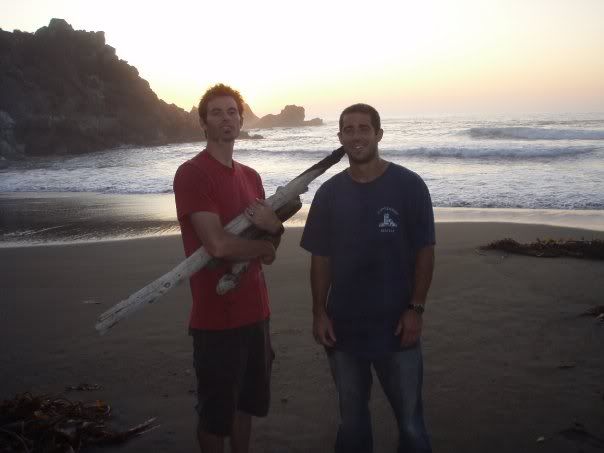
We hauled the wood back up the cliff to the campsite, and Kalvin and I decided to show off our Bear Grylls fire-making skills. This took about 4 hours, due to the driftwood being driftwood, and hence, completely damp. Everyone else was too polite to ask us to hurry the hell up.


We drank beer, ate carne asada, and laughed at Kal’s complete recitation of “Nacho Libre.” Aleida vouched for the authenticity of his accent. When we ran out of beer and jokes, everyone retreated to their sleeping bags and tents.
The next morning, we had a breakfast of I-don’t-remember-what, and then headed out for a last hike. Aleida and Audrey popped in their Ipod ear-buds, and sprinted up a sheer cliff wall. The rest of us followed, shuffling slowly like we were patients at a geriatric ward. When stopping to take pictures, we could see the ash and scorch marks that A&A’s hiking boots had left in their mad dash for the top.
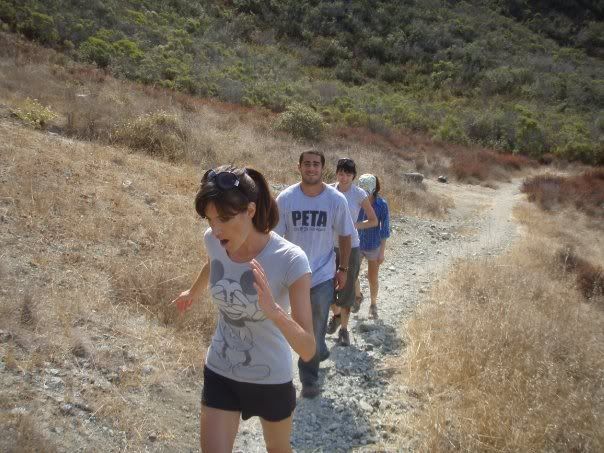
We got to the top, and our two track stars didn’t act impatient with us at all. The view at the top sucked though, so we spent just a few minutes to see how many mosquito bites we could collect, and then turned back.
Lisa and I said our good-byes to the SoCal group, and too quickly, the trip was over.
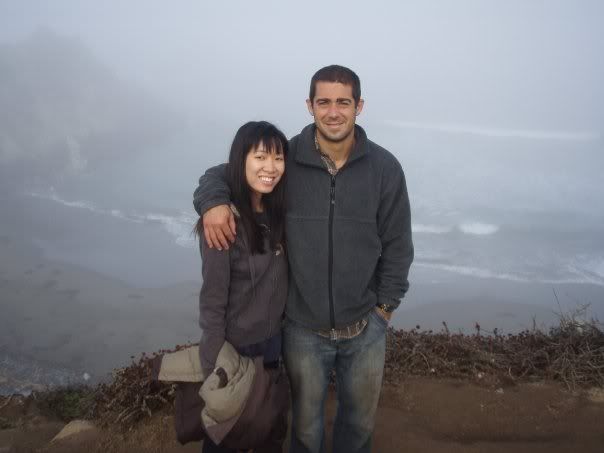

This last trip was at the end of September. Lisa and I drove South from San Francisco and met up with Will, Lina, Kalvin, Audrey, and Aleida in San Luis Obispo. We had our customary sandwiches and beers at the local grocery store, and then debated whether or not to make our hike to the top of the SLO Hill. We always have this debate. The beers are cold and the weather is hot, and trail hiking just seems like too much work. But we always go.

Aleida and Audrey set a land-speed record, finishing the hike in approximately 18 seconds. The rest of us mere mortals followed in the wake of their dust and mocking laughter. Lina was a good sport this time, and didn’t kick dirt in my face. Lisa made her first summit without kicking or screaming at me. We all lounged at the top, drinking the finest of warm, Mexican piss-beer and enjoying the view.


A stop for refreshments, candy, and more beer later, and we were back on the road. We found the spot, which is always a bit tricky, and started bringing our stuff into the forest. I have noticed that bringing women on the camping trips causes the overall volume of supplies to quadruple. I have also noticed that bringing women on the camping trips ensures that dinners don’t consist of beef jerky and trail mix, or God Forbid, Steve’s “coffee.”
We set up tents, and then Kal, Will and I went down to the shore to get driftwood for the fire. Kal jumped into the ocean like a fucking lunatic. Apparently, he doesn’t watch Shark Week, since Nor-Cal is the site for approximately 87% of the world’s Great White Shark attacks. Feeling like a complete Nancy, I stripped and jumped in too. Will doesn’t feel peer pressure, so he just watched and laughed at us.


We hauled the wood back up the cliff to the campsite, and Kalvin and I decided to show off our Bear Grylls fire-making skills. This took about 4 hours, due to the driftwood being driftwood, and hence, completely damp. Everyone else was too polite to ask us to hurry the hell up.


We drank beer, ate carne asada, and laughed at Kal’s complete recitation of “Nacho Libre.” Aleida vouched for the authenticity of his accent. When we ran out of beer and jokes, everyone retreated to their sleeping bags and tents.
The next morning, we had a breakfast of I-don’t-remember-what, and then headed out for a last hike. Aleida and Audrey popped in their Ipod ear-buds, and sprinted up a sheer cliff wall. The rest of us followed, shuffling slowly like we were patients at a geriatric ward. When stopping to take pictures, we could see the ash and scorch marks that A&A’s hiking boots had left in their mad dash for the top.

We got to the top, and our two track stars didn’t act impatient with us at all. The view at the top sucked though, so we spent just a few minutes to see how many mosquito bites we could collect, and then turned back.
Lisa and I said our good-byes to the SoCal group, and too quickly, the trip was over.

Thursday, October 29, 2009
NaNoWriMo - Day 3
Today was my lowest output since starting, and I am currently at only 65% of the volume that I should be at. It wasn't a complete waste though. I spent a lot of time thinking about my story, and I have a much clearer picture of where I want things to go. That doesn't mean that the story will listen, but I do feel a bit more confident than I did yesterday.
Word Count: 607/3,185
Word Count: 607/3,185
Wednesday, October 28, 2009
NaNoWriMo - Day 2
I thought this would be hard, and it's harder than I thought. 2,500 words in and my story is already going all over the place. My characters aren't acting the way they are supposed to, and my plot gets bigger and smaller at the same time. I am also not writing fast enough, due to my desire to edit, erase and change what I have just written.
I need to just let go a bit, word-dump everything for a month, and then pick up the pieces afterward.
No more editing. Even if something new contradicts something old, no more editing.
Word Count: 1,208/2,625
I need to just let go a bit, word-dump everything for a month, and then pick up the pieces afterward.
No more editing. Even if something new contradicts something old, no more editing.
Word Count: 1,208/2,625
Monday, October 26, 2009
NaNoWriMo - Day 1
As my trip to Thailand cuts November a bit short for me, Day 1 of National Writing Month will begin today. Now, actually. Right after this blog post. And after I check facebook one more time.
I am armed with a fresh pot of coffee (black), a phone on silent, a playlist of "This Will Destroy You," and loose scraps of a story that just might turn out to be decent.
I am a bit daunted by the task. I have to write 50,000 words in 30 days, and my current tally is zero.
Here we go.
Word Count: 1,374/1,374
I am armed with a fresh pot of coffee (black), a phone on silent, a playlist of "This Will Destroy You," and loose scraps of a story that just might turn out to be decent.
I am a bit daunted by the task. I have to write 50,000 words in 30 days, and my current tally is zero.
Here we go.
Word Count: 1,374/1,374
Inner Circle Fight Team Represents Half a World Away
Wednesday, October 21, 2009
Rest of '09. Full of Win.
With just over 2 months left, I'm finishing 2009 off with a bang. I have a good solid mix of mental and physical challenges, travel, and time with family and friends.
Mental Challenges
Against my better judgment, I registered for the NaNoWriMo challenge. November is the National Writing Month, and thousands of people worldwide attempt to write 50,000 words over the course of the month. Even though I know that the only way to get better at writing is to write consistently, I still procrastinate and pass on daily writing, way too often. The appeal of a challenge like this is that it forces me to just go, pedal to the metal, for a full month. My last attempt to write a novel ended about 25 pages into it, when I had a bit of a paralysis by over-analysis problem. I would edit and re-read what I had written so much that it would just end up sounding stupid to my ears. Getting 50,000 words down without being able to edit will force me to get my story down on paper. My goal is to finish a complete rough (ROUGH!) draft by the end of November, and then I can spend the time necessary to go over it as much as needed. 50,000 words comes to just under 1,700 a day, and will be about 150 pages. It's insane. Excitement, I has it.
Physical Challenges
On November 7th, I will summit Mt. San Jacinto in Palm Springs, California. My friend and I will start at the desert floor around 3am, and climb 8,000 vertical feet of elevation in about 11 miles. That's the first part. Another 5.5 miles will take us to the actual summit peak, where I expect we will flop to the ground for a half hour, drink a warm beer, gather ourselves enough to take a picture that makes it look like it was easy, and then guzzle water for the return trip. The full mileage will be in either the mid 20's or mid 30's, depending on the route we take down. The heat, vertical climb, and just sheer mileage will make this a test of endurance at least as punishing as the marathon earlier in the year.
Travel
I leave for Thailand on November 27th, and that my friends, will rock. My brother and his girlfriend are already out there, as part of their year-long nomadic adventure, and good times will be had.
There will be at least one work-related trip to Southern California in early November. During that trip, I will get to see my Mom and Grandparents, and make the fool-hardy attempt at Mt. San Jacinto.
There is also a work-related trip to British Columbia, with a date to-be-determined. Depending on when this gets scheduled, I will do my best to allow for a day or two to explore. Supposed to be beautiful up there.
Mental Challenges
Against my better judgment, I registered for the NaNoWriMo challenge. November is the National Writing Month, and thousands of people worldwide attempt to write 50,000 words over the course of the month. Even though I know that the only way to get better at writing is to write consistently, I still procrastinate and pass on daily writing, way too often. The appeal of a challenge like this is that it forces me to just go, pedal to the metal, for a full month. My last attempt to write a novel ended about 25 pages into it, when I had a bit of a paralysis by over-analysis problem. I would edit and re-read what I had written so much that it would just end up sounding stupid to my ears. Getting 50,000 words down without being able to edit will force me to get my story down on paper. My goal is to finish a complete rough (ROUGH!) draft by the end of November, and then I can spend the time necessary to go over it as much as needed. 50,000 words comes to just under 1,700 a day, and will be about 150 pages. It's insane. Excitement, I has it.
Physical Challenges
On November 7th, I will summit Mt. San Jacinto in Palm Springs, California. My friend and I will start at the desert floor around 3am, and climb 8,000 vertical feet of elevation in about 11 miles. That's the first part. Another 5.5 miles will take us to the actual summit peak, where I expect we will flop to the ground for a half hour, drink a warm beer, gather ourselves enough to take a picture that makes it look like it was easy, and then guzzle water for the return trip. The full mileage will be in either the mid 20's or mid 30's, depending on the route we take down. The heat, vertical climb, and just sheer mileage will make this a test of endurance at least as punishing as the marathon earlier in the year.
Travel
I leave for Thailand on November 27th, and that my friends, will rock. My brother and his girlfriend are already out there, as part of their year-long nomadic adventure, and good times will be had.
There will be at least one work-related trip to Southern California in early November. During that trip, I will get to see my Mom and Grandparents, and make the fool-hardy attempt at Mt. San Jacinto.
There is also a work-related trip to British Columbia, with a date to-be-determined. Depending on when this gets scheduled, I will do my best to allow for a day or two to explore. Supposed to be beautiful up there.
Thursday, October 15, 2009
Art of Day to Day Improvement
I have written before about the dangers of multi-tasking. We may or may not end up knocking more "to-do's" off our checklist, but nothing will be done as well as it deserves. Hemingway spoke often of doing a job "properly." It was one of his favorite adverbs, and he learned that from his father. My Father also talks a lot about "doing things right."
But lest you mistake me for someone that has perfected that art, let me correct you. Right before I started this article, I had 5 Firefox tabs open, 2 chat boxes active in AIM, a half-finished work e-mail waiting for me, and I was paying my bills on-line. The "new post" box stayed open and empty for at least 20 minutes before I wrote the opening line.
*Sigh*
There are just so many distractions. In order to avoid feeling like a complete hypocrite, I just closed everything except for this tab and the two reference sites that I will be using.
One trait about me that I am grateful for is that I do insist on improvement. One trait that I am a bit less grateful for is that I have little to no patience for that improvement. If I want to be competent at a certain thing, I want it now, and I will get down on myself for using any time that does not help me get it.
For example, I feel that it is important to be knowledgeable about current events and politics. To make sure that I am, I will engross myself entirely in that pursuit. I will read a newspaper every morning, have a few books on the Middle East going concurrently, watch the Talking Heads babble at me, etc. This will go on for weeks or months, until I have just had entirely too much of it, have burned myself out on it, and don't even want to think about current events for another 6 months. Clearly, this presents quite a consistency problem. You don't become knowledgeable with such an "on again, off again" approach.
I need to start looking at these pursuits more as a marathon than a sprint. A little bit of progress every day. If I don't make it through the entire newspaper, I won't beat myself up about it. If I don't make it to boxing practice, there should be a good reason. If there isn't however, I will do my best to be a little more gentle with myself, and focus on gradual improvement in all areas of my life that are important to me.
Two articles that I found and read today were inspiring and practical. The first was written by Paul Norwine about using the Japanese business principle of Kaizen in your personal life. For those who work in manufacturing and production, you are probably familiar with this term as a way of eliminating all wasted movement and gradual improvement over the long term. Paul turns this principle on our personal lives, and encourages us to aim for daily progression in all areas of your life. I often get bogged down in all the different areas I want to learn about, explore and improve in, and it sometimes leads me to doing none of these things. His post encouraged me to find and focus my priorities, and then aim for small improvements in each of them, every day.
The second was written by Stephen Mills, and deals with avoiding the multi-tasking trap. It relates strongly to my own post on the subject, but reading it around the same time I read Paul's article on Kaizen served as a needed wake-up call and reminder.
Some days will be more productive than others, but as long as we are doing something to further each of our long-term goals, we should find some peace in that.
"Everyday, I am getting better in every way."

But lest you mistake me for someone that has perfected that art, let me correct you. Right before I started this article, I had 5 Firefox tabs open, 2 chat boxes active in AIM, a half-finished work e-mail waiting for me, and I was paying my bills on-line. The "new post" box stayed open and empty for at least 20 minutes before I wrote the opening line.
*Sigh*
There are just so many distractions. In order to avoid feeling like a complete hypocrite, I just closed everything except for this tab and the two reference sites that I will be using.
One trait about me that I am grateful for is that I do insist on improvement. One trait that I am a bit less grateful for is that I have little to no patience for that improvement. If I want to be competent at a certain thing, I want it now, and I will get down on myself for using any time that does not help me get it.
For example, I feel that it is important to be knowledgeable about current events and politics. To make sure that I am, I will engross myself entirely in that pursuit. I will read a newspaper every morning, have a few books on the Middle East going concurrently, watch the Talking Heads babble at me, etc. This will go on for weeks or months, until I have just had entirely too much of it, have burned myself out on it, and don't even want to think about current events for another 6 months. Clearly, this presents quite a consistency problem. You don't become knowledgeable with such an "on again, off again" approach.
I need to start looking at these pursuits more as a marathon than a sprint. A little bit of progress every day. If I don't make it through the entire newspaper, I won't beat myself up about it. If I don't make it to boxing practice, there should be a good reason. If there isn't however, I will do my best to be a little more gentle with myself, and focus on gradual improvement in all areas of my life that are important to me.
Two articles that I found and read today were inspiring and practical. The first was written by Paul Norwine about using the Japanese business principle of Kaizen in your personal life. For those who work in manufacturing and production, you are probably familiar with this term as a way of eliminating all wasted movement and gradual improvement over the long term. Paul turns this principle on our personal lives, and encourages us to aim for daily progression in all areas of your life. I often get bogged down in all the different areas I want to learn about, explore and improve in, and it sometimes leads me to doing none of these things. His post encouraged me to find and focus my priorities, and then aim for small improvements in each of them, every day.
The second was written by Stephen Mills, and deals with avoiding the multi-tasking trap. It relates strongly to my own post on the subject, but reading it around the same time I read Paul's article on Kaizen served as a needed wake-up call and reminder.
Some days will be more productive than others, but as long as we are doing something to further each of our long-term goals, we should find some peace in that.
"Everyday, I am getting better in every way."

Monday, October 12, 2009
The Importance of Beards
I just made myself a cup of 3:00pm coffee. I drink coffee on a fairly regular schedule. 1-2 cups before work as I read the paper or whatever book I am working through, a cup around 3pm, which is designed to kick start some energy to charge the rest of the work day, and then one last cup right before I leave work for the gym. That final cup is accompanied by 500mg of aspirin and a B-vitamin complex. I think the current cup of coffee may be accompanied by creamer that has gone bad. It's some of that flavored creamer...the kind with a name like "hazelnut," or "french vanilla." The "sell by" date is October 3rd, and today is the 12th. Then again, it's the "sell by" date and not the "don't drink after" date. It's also fake food, full of the chemicals and ingredients that will preserve it a generation longer than real milk. I'm pretty sure that this stuff would survive a nuclear winter. In any case, I'm going to finish the cup, regardless of what you think about it.
What prompted this reverie was my musing on an age-old question that I will soon have to answer. As my departure date for Thailand draws near, I need to decide whether or not to grow the vacation beard. I know. Serious business. Before tackling such weighty matters, I felt the need for coffee to kick-start my snoozing brain synapses. That's what led to my introductory paragraph.
Anyway.
Yes, beards are itchy and they tend to accumulate dirt, debris and food crumbs. Worth it. Beards speak to freedom. They come from a time when the workplace required such trappings. You know, back in the day when all men were lumberjacks. Obviously, beards were necessary as protection when engaged in such activities. Now we're all stuck behind our computer screens, sending e-mail and cold-calling prospects. Clearly, no protection is needed in such an environment, and cheek-whiskers would be overkill.
My departure date is late November, and clearly, with a schedule packed full of such goodies as kickboxing, canoeing, backpacking, the drinking of cheap whiskey, the consumption of fried street food, and debauchery on a never-before-seen scale, a beard will be needed for protection.
Besides, when adventuring in the exotic pearl that is South-East Asia, would you rather look like:
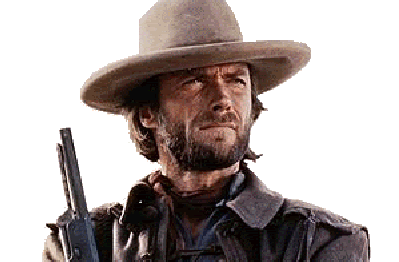
Or

I rest my case.
What prompted this reverie was my musing on an age-old question that I will soon have to answer. As my departure date for Thailand draws near, I need to decide whether or not to grow the vacation beard. I know. Serious business. Before tackling such weighty matters, I felt the need for coffee to kick-start my snoozing brain synapses. That's what led to my introductory paragraph.
Anyway.
Yes, beards are itchy and they tend to accumulate dirt, debris and food crumbs. Worth it. Beards speak to freedom. They come from a time when the workplace required such trappings. You know, back in the day when all men were lumberjacks. Obviously, beards were necessary as protection when engaged in such activities. Now we're all stuck behind our computer screens, sending e-mail and cold-calling prospects. Clearly, no protection is needed in such an environment, and cheek-whiskers would be overkill.
My departure date is late November, and clearly, with a schedule packed full of such goodies as kickboxing, canoeing, backpacking, the drinking of cheap whiskey, the consumption of fried street food, and debauchery on a never-before-seen scale, a beard will be needed for protection.
Besides, when adventuring in the exotic pearl that is South-East Asia, would you rather look like:

Or

I rest my case.
New and Depressing Age for Journalism
I miss the Walter Cronkite-type of newscast. It speaks to a simpler time. There were clearly delineated lines between black and white, right and wrong. There was more optimism; a belief that American virtues of hard work, persistence, and determination could solve any problem. The perceived need for 24 hour news has bred the type of "talking heads" programs where opposing characters shout at each other for an hour. No ground is gained, no consensus formed, no compromise reached, and it appears that any sense of respect for others is too much to ask for. And that is the way it is.


Friday, October 9, 2009
Anaerobic vs. Aerobic Training for Combat Athletes
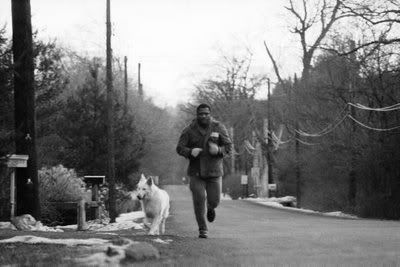
Disclaimer: I am not a trainer, nor do I have any degree or certification in sports performance.
Over the last decade and a half, more and more "modern" athletes and trainers have turned away from the morning "roadwork" that combat athletes have relied on for centuries. The long distance work that generations of successful fighters have used for conditioning (mind & body) have been pooh-poohed as "backwards," and "unsuitable" for explosive sports like boxing or MMA.
High Intensity Interval Training (HIIT) can be summarized as a series of all-out sprints of activity, followed by full or partial rest periods. The most famous study was directed by Dr. Izumi Tabata from the National Institute of Fitness and Sports in Tokyo, Japan. What would become known as the "Tabata Principle" consisted of 4 minutes of training, broken down into 20 seconds of all-out effort, followed by 10 seconds of rest, continued 8 times, for a total of 240 seconds. After 6 weeks of training, Dr. Tabata found that his athletes improved 28% in anaerobic capacity, and 14% in their ability to consume oxygen (VO2 Max/aerobic).
There is no doubt that interval training is intense, time-efficient, and effective. If anyone doubts it, just try it on the track. That being said, so many people now tout it as the end-all, be-all of conditioning, that steady pace distance running is completely disregarded. The following statements are heard often:
"MMA is a sprint, not a marathon."
"Long , slow distance running doesn't have a place in a sport that is as explosive as MMA (or boxing.)"
"Slow running changes fast-twitch muscle fibers to slow ones, limiting an athlete's ability to react quickly and explosively."
These comments have some basis in fact, but they ignore certain parts of the Tabata study, and are misleading in some ways.
For one thing, the Tabata study makes a big deal out of the improvements taking place on "trained athletes." This is important, as it is much harder to get significant results out of athletes already "in shape," compared to relative novices. In fact, the athletes in the study had decent, but not great VO2 max averages before starting the study. The argument that similar improvements could be made with other training protocols, especially since these are relatively un-trained athletes, rarely gets made.
Secondly, even the group of athletes who were being trained with the Tabata Protocol were also instructed to perform LSD (Long, Steady Distance) runs once a week.
Finally, are we sure that combat sports are REALLY anaerobic in nature?
Aerobic means "with oxygen," and being in an aerobic state is when the body's demands for oxygen and fuel can be met by the body's intake. (breathing in oxygen) An extreme example of an aerobic athlete is a marathon runner.
Anaerobic means "without oxygen," and the system is used under maximal effort, where the body is working so hard that the demands for oxygen and fuel exceed the supply. The body must then rely on the stored reserves of fuel. An extreme example of an anaerobic athlete is a 100 meter sprinter.
The problem with the argument that combat sports are anaerobic is that this system can only operate for a short time before it is spent. Once that happens, the demands for fuel and oxygen must be supported and replenished with the aerobic system. This happens QUICKLY. In fact, by the time that maximum effort has passed 75 seconds, more than half of the energy being used is supplied by the aerobic system. During the two minute rounds of amateur boxing, 63% of the energy requirements are coming via the aerobic system. With professional boxing and MMA fights lasting as long 48 minutes, broken into 3-5 minute rounds, it is clear that these are not purely anaerobic activities.
The point of all this is that the title is misleading. There should not be a question of anaerobic OR aerobic training, but just a matter of using both to bring up your weaknesses. If you come from a sprint-heavy background before beginning training in combat sports, you will most likely benefit from longer distance-style training. This will help lower your resting heart rate, and allow for quicker recovery between rounds. Conversely, if your resting heart rate is low, but you are lacking in speed and power, you may want to place an emphasis on interval training to bring up the lagging areas.
In short, each is good, but both is better.
Further Reading
http://www.brianmac.co.uk/enduranc.htm
http://ezinearticles.com/?Tabata-Anything---Four-Minutes-of-Pain-to-Gain&id=348486
http://8weeksout.com/
Wednesday, October 7, 2009
Mind Over Matter
Dean Karnazes is a freak of nature.
Thinking back on my first (and only) marathon, my mind jumps immediately to the pain of cramped muscles and the constant pounding on my knees and feet. At 26.2 miles, a marathon is about as far from a sprint as it is possible to get. As such, I didn't feel too winded either during or after the race. What I did feel was near failure in the muscles, tendons and ligaments of my legs and feet.
Long-distance running is not glamorous like the 100 and 200 meter dash. There is no explosive motion or energy. There is no eye-popping speed. Long races, endurance work; they are all about mental toughness. If your hamstrings cramp and seize at the 16 mile mark, you have another 10 MILES to think about it and deal with it. Unless you quit, your only option is to recognize the pain, acknowledge it, and carry on with your task despite the presence of it.
Most people run a marathon, they walk like they have been prison-raped for the next few days. Experienced campaigners and world-level runners, they may take weeks or months to be ready for another go at it. Dean Karnazes ran 50 marathons in 50 days...in 50 different states. The endurance required for such a feat is impressive, but the powers of recovery are simply mind-boggling. The human body is just not designed to take that kind of pounding.
As expected from a supreme athlete in a sport that requires chart-topping levels of mental fortitude, Karnazes views his mind as the most important muscle in the body. "The human body has limitations," Karnazes says. "The human spirit is boundless."
Testing the limits of human performance requires a deep and abiding tolerance and acceptance of pain. Before running the Badwater Ultra Marathon, he trained in the high heat of summer wearing a ski parka over a hooded sweatshirt. He trained so hard and so long that the extreme became normal and expected. Pain, while never a friend, became at least an old and familiar companion.
Based out of San Francisco, California, Karnazes finished his 50th and final marathon of the tour in New York City. He then ran home.

Thinking back on my first (and only) marathon, my mind jumps immediately to the pain of cramped muscles and the constant pounding on my knees and feet. At 26.2 miles, a marathon is about as far from a sprint as it is possible to get. As such, I didn't feel too winded either during or after the race. What I did feel was near failure in the muscles, tendons and ligaments of my legs and feet.
Long-distance running is not glamorous like the 100 and 200 meter dash. There is no explosive motion or energy. There is no eye-popping speed. Long races, endurance work; they are all about mental toughness. If your hamstrings cramp and seize at the 16 mile mark, you have another 10 MILES to think about it and deal with it. Unless you quit, your only option is to recognize the pain, acknowledge it, and carry on with your task despite the presence of it.
Most people run a marathon, they walk like they have been prison-raped for the next few days. Experienced campaigners and world-level runners, they may take weeks or months to be ready for another go at it. Dean Karnazes ran 50 marathons in 50 days...in 50 different states. The endurance required for such a feat is impressive, but the powers of recovery are simply mind-boggling. The human body is just not designed to take that kind of pounding.
As expected from a supreme athlete in a sport that requires chart-topping levels of mental fortitude, Karnazes views his mind as the most important muscle in the body. "The human body has limitations," Karnazes says. "The human spirit is boundless."
Testing the limits of human performance requires a deep and abiding tolerance and acceptance of pain. Before running the Badwater Ultra Marathon, he trained in the high heat of summer wearing a ski parka over a hooded sweatshirt. He trained so hard and so long that the extreme became normal and expected. Pain, while never a friend, became at least an old and familiar companion.
Based out of San Francisco, California, Karnazes finished his 50th and final marathon of the tour in New York City. He then ran home.

Tuesday, October 6, 2009
Fight Summary - October 2nd, University of San Francisco
Focusing Intensely vs. Multi-Tasking

The ability to "multi-task" has long been seen as a good and necessary quality for the modern worker to possess. We all write it on our resume next to other complimentary descriptions, such as "good team player," and "proven leader." Multi-tasking has been seen as a vital part of today's workplace, because, the theory goes, business moves too fast these days to only focus on one thing at a time.
This ignores the fact that it is physically impossible for a person to be thinking of two separate things simultaneously. We are unable to hold more than one thought in our mind at any given instant. The idea of multi-tasking requires us to split time between two or more projects, transferring our focus from one to the next, defusing our ability to concentrate, and short-changing each. Take, for example, a case where you are on the phone and checking e-mail at the same time. Both of these tasks suffer in our attempt to "get things done." We are not able to give the person on the phone the focus that they deserve, and we can't really believe that they we are getting any deep reading done either.
These and other similar situations should be handled separately, allowing yourself to give each of them as close to 100% of your focus as possible. A related, but slightly different habit is allowing yourself to get distracted from meaningful work for small, less-important tasks. E-mail is probably the most common example. After a small distraction like e-mail, it can take us 5 or more minutes to refocus on whatever we were working on before the interruption.
Creating and using time-blocks seems to be the answer. These are periods of time where you focus entirely on the project you have chosen. We don't work in a vacuum, so yes, distractions will happen. A client, colleague or your boss may come up to you right when you achieve your Zen Buddhist state of concentration and insist that you handle something completely separate. And yes, sometimes emergencies will come up. That being said, do what you can to minimize non-vital distractions. Perhaps close out Outlook, or at least turn off the volume so that you don't hear the alerts as each new e-mail comes in. What your time blocks are made up of, and how long you devote to each is dependent on your particular job, goals and the amount of time you are able to concentrate on one task. If your job is heavily dependent on e-mail, you may want to schedule that first. Other time blocks can be for work on an upcoming presentation, business trip, or inter-staff meeting. Take short breaks in between each block if time is available. A walk around the block, or just getting up to get water can suffice. Do your best to focus entirely on that one goal for the time period to the exclusion of all else.
We should endeavor to feel better on a task done well than the number of "to-do's" checked off your list at the end of the day.
Thursday, October 1, 2009
The Dangers of a Safety-First Mentality
In sports, the "Safety-First" mindset is often characterized by players known to play NOT to lose, rather than playing to win. This occurs when the pressure, fear and anxiety of all the conflicting feelings and emotions get the better of a person. It has become more desirable for the athlete to focus their efforts on avoiding embarrassment or injury, and they sacrifice the glory or victory that could be obtained by being willing to take risks. Being intimidated by the circumstances that the athlete has found himself in convince him that it is better, smarter and safer to stick to the status quo. The downside is that he finds himself tight, stiff and unable to react or make changes to the different "looks" his opponent shows him.
Combat sports bring this mindset to the forefront. It's one thing to be "safety-first" in basketball, where the pain of losing or being embarrassed, while real and traumatizing, is all that is risked. In boxing, grappling, and other martial arts, the athlete is faced with the very real danger of serious bodily injury. He still has the emotional fears that go along with other sports of being up-staged, humiliated, and made to look bad. There is nothing quite like getting your ass kicked in front of people that care about you.
In boxing, there is a whole sub-species of fighter that is known as a "Gym Warrior," who embodies this mindset perfectly. Often very talented, they are known to get the better of top-flight fighters in the relative safety of a hard sparring session. They work hard, train hard and smart, and can often be the most skilled fighter around. However, once you add an audience and the bright lights over the squared circle, they fall far short of their capabilities. The emotional stress overcomes them, and they lose to inferior fighters.
Success in boxing (and everything else) requires us to take risks at the right time. Some will work, some will not, but they need to be taken to have a chance at winning. Preparing yourself physically is a given. Preparing yourself mentally is the harder part. Experienced athletes develop consistent rituals for the days, minutes and seconds leading right up to competition. Some meditate, some focus on deep breathing, some work to convince themselves that it's "just another day," but they all do something to kill the waiting time. Whatever works for you, don't be a gym warrior. Whether your battles are in the ring, in the cage or in the boardroom, rise to the occasion, thrive on pressure, ignore the desire to avoid risk, and perform at your best.
Combat sports bring this mindset to the forefront. It's one thing to be "safety-first" in basketball, where the pain of losing or being embarrassed, while real and traumatizing, is all that is risked. In boxing, grappling, and other martial arts, the athlete is faced with the very real danger of serious bodily injury. He still has the emotional fears that go along with other sports of being up-staged, humiliated, and made to look bad. There is nothing quite like getting your ass kicked in front of people that care about you.
In boxing, there is a whole sub-species of fighter that is known as a "Gym Warrior," who embodies this mindset perfectly. Often very talented, they are known to get the better of top-flight fighters in the relative safety of a hard sparring session. They work hard, train hard and smart, and can often be the most skilled fighter around. However, once you add an audience and the bright lights over the squared circle, they fall far short of their capabilities. The emotional stress overcomes them, and they lose to inferior fighters.
Success in boxing (and everything else) requires us to take risks at the right time. Some will work, some will not, but they need to be taken to have a chance at winning. Preparing yourself physically is a given. Preparing yourself mentally is the harder part. Experienced athletes develop consistent rituals for the days, minutes and seconds leading right up to competition. Some meditate, some focus on deep breathing, some work to convince themselves that it's "just another day," but they all do something to kill the waiting time. Whatever works for you, don't be a gym warrior. Whether your battles are in the ring, in the cage or in the boardroom, rise to the occasion, thrive on pressure, ignore the desire to avoid risk, and perform at your best.
Subscribe to:
Posts (Atom)
